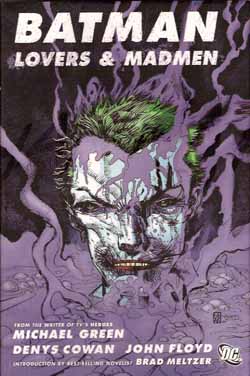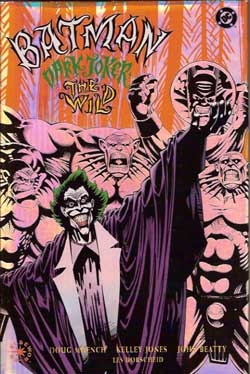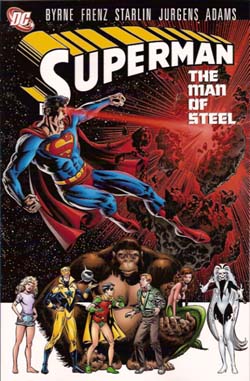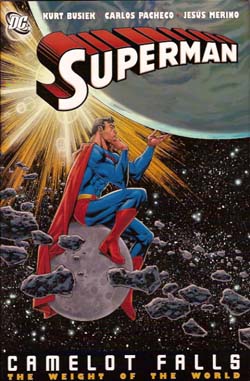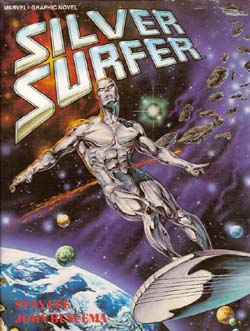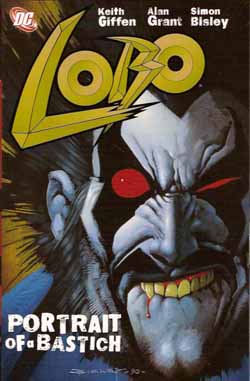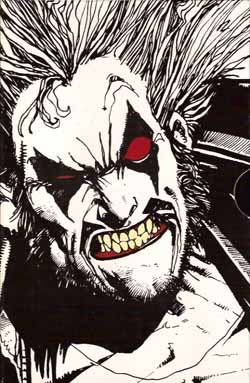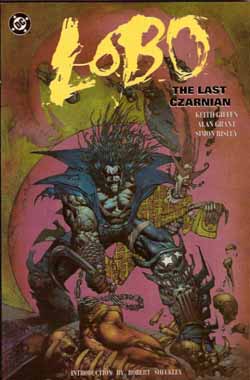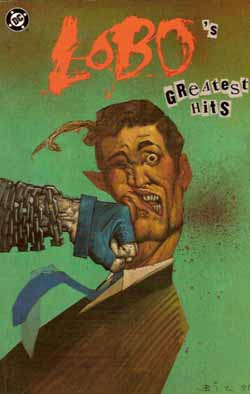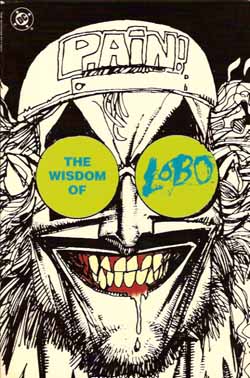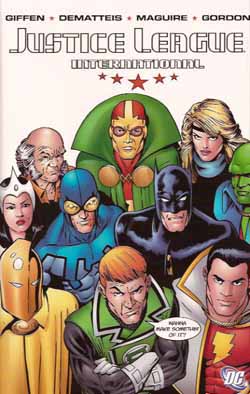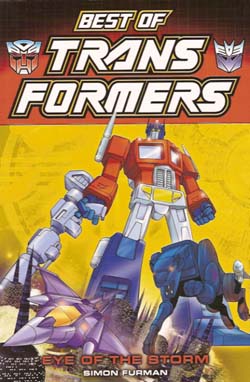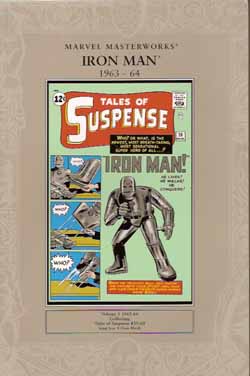
By Stan Lee, Don Heck, Jack Kirby, Steve Ditko & various (Marvel/Panini UK)
ISBN: 978-1-905239-86-3
There are a number of ways to interpret the creation and early years of Iron Man and his alter-ego Tony Stark, celebrity millionaire industrialist and inventor – but as that cinema release looms ever nearer (and since I’ve scrupulously avoided learning anything about it) we’ll be concentrating solely on the original comics material rather than any refits since. At least this lovely, economical full-colour trade paperback presents the first two years in a highly accessible package that will hopefully answer a demand from movie-goers with some of Marvel’s very best tales.
Created in the aftermath of the Cuban Missile Crisis and at a time when “Red-baiting†and “Commie-bashing†were national obsessions in the U.S., the emergence of a brilliant new Thomas Edison, using Yankee ingenuity and invention to safeguard the World, was an inevitable proposition. Combining the cherished belief that Yankee technology could solve every problem with universal imagery of noble knights battling evil and the proposition became certainty. Of course kids thought it great fun and very, very cool…
This compendium of the Golden Avenger’s natal years reprints all his solo adventures, plus some feature pages and pin-ups, from Tales of Suspense #39 (cover-dated March 1962) to #60 (December 1964); the dawn of the company’s rebirth to the beginning of their commercial expansion, a period which saw them challenge DC’s position of dominance, but still prior to Marvel becoming the darlings of the student counter-culture. In these tales Tony Stark is still very much the patriotic armaments manufacturer, and not the enlightened capitalist dissenter he would become.
TOS #39, scripted by Larry Lieber (over brother Stan Lee’s plot) and illustrated by the criminally unappreciated Don Heck, featured ‘Iron Man is Born’, wherein electronics wizard Tony Stark is field testing his latest invention in Viet Nam when he is wounded by a landmine. Captured by the Viet Cong commander Wong-Chu, he is given a grim ultimatum. Create weapons for the Reds and a doctor will remove shrapnel from his chest that will kill him within seven days. If not…
Knowing Commies can’t be trusted, Stark and aged Professor Yinsen – another captive scientist – build a mobile iron lung (remember this was years before heart transplants and pace-makers) to keep his heart beating, and they equip it with all the weapons that their ingenuity and resources can secretly build. Naturally they succeed, defeating Wong-Chu, but not without tragic sacrifice.
From the next issue Iron Man’s superhero career is taken as a given, and he has already achieved fame for largely off-camera exploits. Lee continues to plot but Robert Bernstein replaces Lieber as scripter for issues #40-46 and Jack Kirby shares the pencilling chores with Heck. ‘Iron Man versus Gargantus’ follows the new Marvel pattern by pitting the hero against aliens – albeit via their robotic giant caveman intermediary, in a delightfully simplistic romp pencilled by Kirby and inked by Heck.
‘The Stronghold of Doctor Strange’ (art by Kirby and Dick Ayers) is a gripping battle with a wizard of Science (and not the Lee/Ditko Master of the Mystic Arts), whilst Heck returns to full art for the spy thriller ‘Trapped by the Red Barbarian’.
Kirby and Heck team again for the science-fantasy ‘Kala, Queen of the Netherworld!’, then Heck goes it alone when Iron Man time-travels to ancient Egypt to help Cleopatra against ‘The Mad Pharaoh!’, withstands ‘The Icy Fingers of Jack Frost!’ and faces his Soviet counterpart ‘The Crimson Dynamo!’.
Tales of Suspense #47 presaged big changes. Stan Lee wrote ‘Iron Man Battles the Melter!‘, and Heck inked the unique pencils of Steve Ditko, but the major event came with the next issue. In ‘The Mysterious Mr. Doll’ Lee, Ditko and Ayers scrapped the old cool-yet-clunky boiler-plate suit for a sleek, form-fitting, red-and-gold upgrade that would (with minor variations) become the character’s trademark for decades.
Paul Reinman inked Ditko on Lee’s crossover/sales pitch for the new X-Men comic in ‘Iron Man Meets the Angel’, but the series only really took hold with Tales of Suspense #50. Don Heck returned as regular penciller and occasional inker, and Lee introduced the hero’s first major menace in ‘The Hands of the Mandarin’, a modern Fu Manchu who terrified the Red Chinese so much they tricked him into attacking America in the hope that one threat would destroy the other. The Mandarin would become arguably Iron Man’s greatest foe.
Our hero made short work of criminal contortionist ‘The Sinister Scarecrow’, and the Red spy who stole that Russian armour-suit when ‘The Crimson Dynamo Strikes Again’ (#52) – scripted, as was the next issue, by the mysterious “N. Korokâ€- but it introduced a much greater threat in the slinky shape of the Soviet Femme Fatale the Black Widow. With TOS #53, she returned when ‘The Black Widow Strikes Again!’
‘The Mandarin’s Revenge!’ followed; a two-part tale that concluded with #55’s ‘No One Escapes the Mandarin!’, but ‘The Uncanny Unicorn!’ promptly attacked after Iron Man did, only to fare no better in the end. The Black Widow resurfaced to beguile budding superhero ‘Hawkeye, the Markman!’ into attacking the Golden Avenger in #57, before another landmark occurred in the next issue.
Iron Man had monopolised Tales of Suspense, but ‘In Mortal Combat with Captain America’ (inked by Dick Ayers) featured an all-out scrap between the two heroes resulting from a clever impersonation by the evil Chameleon. It was a taster for the next issue when Cap began his own solo adventures, splitting the monthly comic into an anthology featuring Marvel’s top patriotic heroes.
Iron Man’s outing in TOS #59 was against the technological paladin ‘The Black Knight!’, and as a result Stark was unable to remove the armour without triggering a heart attack, a situation that hadn’t occurred since the initial injury. Until this time he had led a relatively normal life by simply wearing the life-sustaining breast-plate under his clothes. The introduction of soap-opera sub-plots were a necessity of the shorter page counts, as were continued stories, but this seeming disadvantage actually worked to improve both the writing and the sales.
With Stark’s “disappearance,†Iron Man was ‘Suspected of Murder’, a tale that featured the return of Hawkeye and the Black Widow, and which closed the (publishing) year and this book on something of a cliff-hanger, albeit a partial one. The following issues – and if the film’s a success, the next volume – should conclude the drama with ‘The Death of Tony Stark!’ and ‘The Origin of the Mandarin!’, so keep your fingers crossed.
Iron Man developed amidst the growing political awareness of the Viet Nam Generation who were the comic’s maturing readership. Wedded as it was to the American Industrial-Military Complex, with a hero – originally the government’s wide-eyed golden boy – gradually becoming attuned to his country’s growing divisions, it was, as much as Spider-Man, a bellwether of the times. That it remains such a thrilling uncomplicated romp of classic super-hero fun is a lasting tribute to the talents of all those superb creators that worked it. And it’s a salute to the character’s corporate-capitalist ethos that it took a big-budget blockbuster to catapult these great stories out into a mainstream marketplace.
So why not exploit the chance to get this fabulous, economical tome and relive some classic moments in history – especially if it’s for the very first time?
© 1963, 1964, 2007 Marvel Characters, Inc. All Rights Reserved.
